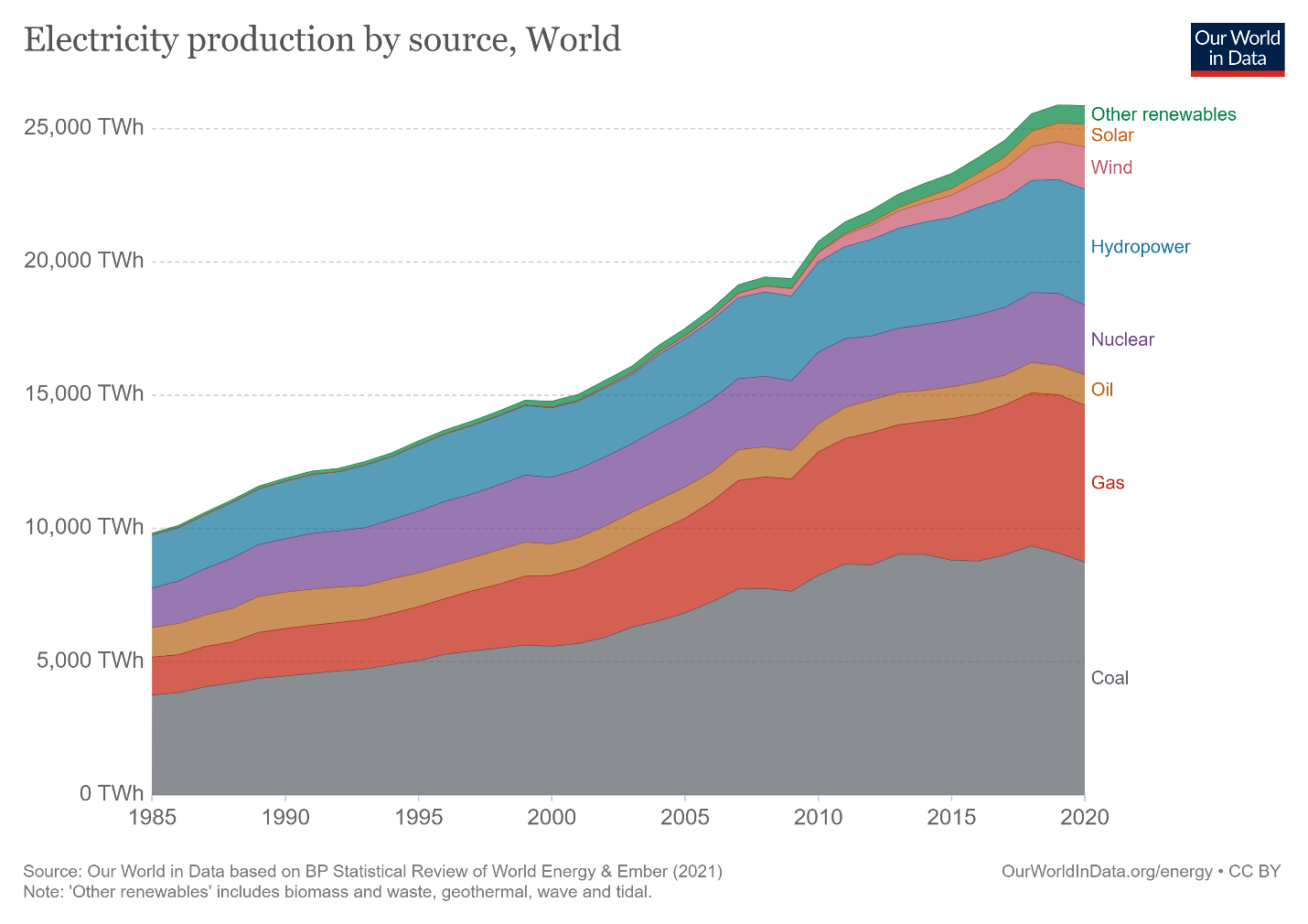We learned from the previous episode the rate of consumption of 5 primary energy sources over a period of 50 years (1965 to 2015). It was crystal clear that the rate of consumption of three of them, oil, coal and natural gas, which were fossil fuels, grew steadily significantly, and 2015, were they generated about 50000, 40000 and 35000TWh/y respectively. The other 2 primary energies were nuclear power (NP) and renewables (Res); the latter includes biomass, hydro power (HP), wind power (WP), solar power (SP) and geothermal. NP and Renewables, recognized as low-carbon energy sources, generated in 2015 only about 2000 and 3000TWh/y of energy respectively.
Fossil fuels are used broadly across all sectors of the economy, most notably transport, industries, electricity production and domestic energy use. Out of the 5 renewable energy sources, only biomass can be used to provide heat in the industrial and domestic sectors. Otherwise, Res and NP are mainly used to generate electricity.
Quite unfortunately, fossil fuels, especially coal and oil, profusely pollute the environment, and are the leading cause of global warming and climate change, the existential threat for the survival of our planet. That is why all nations are obliged by the dictate of the Nationally Determined Contribution in the Paris Climate Change Agreement, to curb their carbon emissions with an optimal goal of zero emission by 2050.

Therefore, it is expected that, NP and Res, which are low-carbon technologies, can be scaled up to provide all necessary energies for all the economic sectors in the pending low-carbon economy. However, there is largely no consensus as to how to approach the dilemma of providing abundant and affordable electricity needed for economic growth while ensuring carbon emissions are curbed to meet our obligations to mother Earth.
The Depth of the Task
We shall certainly appreciate the depth of the problem with the help of very illustrative figures. The first one is taken from the special report on renewables by IPCC in 2011 (SRREN). Figure1 is on Shares on Energy Sources in the total Global Primary Energies in 2008. Note in this figure that the data is presented in percentages, which are easier to understand. Figure1 shows that 85.1% of all energy consumed in 2008 came from fossil fuel, while NP and Res accounted for only 2.0 and 12.9% respectively.
The share of REs was dominated by 10.2 and 2.3% from bio-energy and HP respectively. The shares for WP and SP were 0.2 and 0.1% respectively, another 0.1% from geothermal. Out of the above-mentioned REs, only WP and SP from inexhaustible sources are exploitable, and they have been the fastest growing energy technologies for decades, but the resulting generated electricity is woefully low, simply due to their capacity factors, which we will review in detail below.
To deepen our understanding about of the huge task of transitioning to a low-carbon economy while retaining our current standard of living, we need to compare what we have learned from Figure 1 with 2008 data with Figures 2 and 3 with the latest data from 2020. The figures, Figure2 and Figure3 are from an article Electricity Mix by Hannah Ritchie, published recently in a scientific magazine Our World in Data.
Note in Figure2 that fossil fuels and low-carbon options respectively accounted for 64.3 and 36.7% of electricity generated in the world in 2020. Since our interest is the share of Res, let’s note that, that will be will be 26.3%, with 15.8, 5.3, 2.7 and 2.5% from HP, WP, SP and others respectively.
Figure2 also shows that fossil fuels accounted for 84.3% of total energy in 2020, with only 15.7% derived from low-carbon primary energies. The fastest growing options, WP and SP, which are tipped to be our “prime” sources of energy in a low-carbon world, when fossil fuels are phased out. It is very crucial to take note, however, that WP and SP, the fastest growing energy technologies accounted for only 2.2 and 1.1% respectively of the total energy of 2020.

Figure3 sums up all that has been said in our discussions about the reliable pathway to a low-carbon economy. Obviously, what is needed are options that can abundantly generate clean, reliable and affordable electricity to replace fossil fuels in all the economic sectors.
Capacity Factors
Capacity factors (CFs) also known as load factors, are used in the energy sector to describe the effectiveness of energy sources used for power generation. CF is generally high for conventional sources, but NP often stands out with the highest CF in any energy-mix. in the case of Res, CFs for geothermal and biomass re relatively, and they are followed by CFs of HP, WP and SP. Moreover, CFs for WP and SP are adversely affected by several conditions, which for SP of includes shade, soot, dust, bird droppings and leaves. The CF for WP is adversely affected by large structures including trees and nearby wind turbines.
To gain a better appreciation of CFs, we shall calculate the CFs for HP, WP, SP and NP, with the raw data from the fact-sheets of a very competent source, the Clean Energy Wire, a German energy magazine. We are interested in only the installed capacities (measured in GW), and the generated electricity (measured in TWh) in the year 2020. Note that in the brackets for the selected energy sources are 2 figures, the first one is the installed capacity in GW, and the other is the generated electricity in TWh.
HP (4.8. 18.5), WP (54.5, 105.3), SP (53.1, 50.4) and NP (8.1, 64.3). As stated above, WP and SP are the fastest growing energy technologies, and their installed generating capacities in 2020 in Germany were 54.5 and 53.1GW respectively. On the other hand, the installed capacities of HP and NP were 4.8 and 8.1 GW respectively. It is also worth noting that 8.1GW NP produced 64.3TWh of electricity, which was more than 50.4TWh produced by 55.1GW SP.
To find the CF of NP, we have to divide its generated electricity of 64.3TWh by the product of its installed capacity of 8.1GW and 8760 hours, the number of hours in a year. Thus CF=64.3TWh/(8.1GW x 8760h) =90.6%. In similar manner, the CFs for SP, WP and HP were found to be 10.8, 22.1, and 44.0% respectively. The CF of 90.6% underscores the fact that NP produces electricity more abundantly than all the other options for power generation.

Note from the above-given data that the installed capacity of HP, which has a higher CF than WP and SP, was only 4.5GW respectively in 2020, as compared to their respective value of 5.4GW in 2010, showing slight changes. In the same period, the installed capacity of 26.8GW for WP, more than doubled to 54.5GW, while that for SP, 18.0 GW, nearly tripled to 53.1GW. This underscores the fact that while WP and SP are the fastest growing energy technologies, the generated electricity is not as impressive due to their low CFs. In addition, only WP and SP are variable and intermittent energy sources which do not produce dispatchable electricity for the grid, and as such they require reliable back-up options, which are usually derived from coal or natural gas power plants.
Nuclear Power is Hardly Mentioned at Climate Change Meetings
Since the COP6 at The Hague in the Netherlands in 2000 (which was meant to finalize the Kyoto Protocol) collapsed, 2 proposals for emission credits has been tabled by the Umbrella Group of advanced countries, such as Canada, Japan, Russia, Australia and others, and led by the USA. The two proposals were: (1) Using NP as a CDM project, and (2) Using their forests as carbon sinks. The collapsed COP6 was rescheduled as the COP6/2 which met in Bonn, Germany in July 2001, where the proposal of using forests for emission credits was accepted, but the advanced countries were asked to refrain from using NP for emission credits.
Note that the USA has the largest fleet of power reactors in the world and operating NP safely for more than 50-60 years. Likewise, France, where over 70% of their electricity is derived from NP, has lowest carbon intensity in the energy sector, and for decades, many European countries import energy from France due to its reliable supply of electricity.
Unfortunately NP is hardly mentioned at climate change meetings and there is a concerted effort to ignore the the the potential of NP. SDG 7 established by the UN General Assembly focuses on “ensuring access to affordable, reliable, sustainable and modern energy for all” does not include NP in its scope of clean energy technologies. This is despite the fact that NP has the safest record of all the energy sources, the highest CF and presents the most cost-effective option to mitigate climate change and produce reliable and affordable electricity more abundantly than any other option. To have a meaningful discussion on how to transition to a low-carbon economy, we must follow the science and fully assess the true capacities of the energy options available to us.










